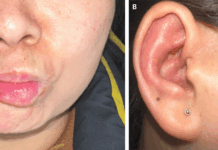“All that glitters is not gold”, similarly all tattoos don’t end up looking cool, instead sometimes our body fails to accept the fact that we got a tattoo, hence the allergic reaction to the tattoo of our dreams!
The image above is of a two weeks’ old tattoo on the left arm of a 37-year-old, otherwise healthy woman who presented with complaints of gradually progressive itching and swelling within the boundaries of her tattoo, unaccompanied by fever or any other symptoms. She got the tattoo placed from a tattoo parlor using red ink which elicited the allergic reaction, gradually worsening over a period of two weeks. It was unresponsive to topical application of 1% hydrocortisone cream (low potency steroid). A noteworthy point here is that the patient neither had a history of any allergies, nor recent trauma, travel or animal exposure.
The prevalence of Body Art (body piercing and tattooing) is increasing day by day, hence the medical complications related to it are rising, but unfortunately less information is available due to infrequent reporting of such complications. Nevertheless, even with a limited literature, we know that the two most common complications are: 1) local infections and 2) skin reactions. Though the infection can be systemic too, that is less frequent than localized infection, occurring specifically in those who fail to follow aftercare instructions, also Hepatitis B, Hepatitis C, and HIV can be transmitted during tattooing. Moreover, some inks are carcinogenic, confirmed by a study issued by the Australian government which revealed that 22% of the tattoo inks tested contained carcinogens.
The case in discussion here is of the second type of complication mentioned above i.e. skin reaction. Skin reactions to the tattoo ink, be it a permanent tattoo or a temporary one, ranges from a local skin reaction to serious hypersensitivity reactions.
Is our skin the culprit or the tattoo pigment?
The answer can be either of them; as far as inks are concerned, permanent tattoos that use metallic salts (mercury, cobalt, nickel) are associated with delayed hypersensitivity reactions. Since tattoo pigments are color additives, these come under the umbrella of Federal Food and Cosmetic authority, therefore some are not reviewed by FDA for intradermal use. Thus, many of these contain non-standardized material that hasn’t been approved for use within our skin. العاب للفوز بجوائز حقيقية Temporary tattoos, such as black henna may present with contact allergy due to a highly sensitizing allergen called paraphenylenediamine, but this is far less common than permanent tattoo reactions. The treatment of such allergic reactions is topical glucocorticoids whereas, for tattoos that develop infections, antimicrobials are warranted.
Can we do anything to keep our tattoos all pretty? شرح بوكر
Definitely yes!
Tattoos take two weeks to heal, meanwhile, it should be kept clean and moist with Vaseline or a similar ointment, avoid the sun or apply sunscreen, avoid tight clothing, swimming, and direct shower jet. شرح بلاك جاك Having said that, this doesn’t free tattoo artists from their responsibility of using aseptic techniques and approved tattoo inks.
Food for thought:
If tattoo pigment has metallic salts, is it safe for MRI?





